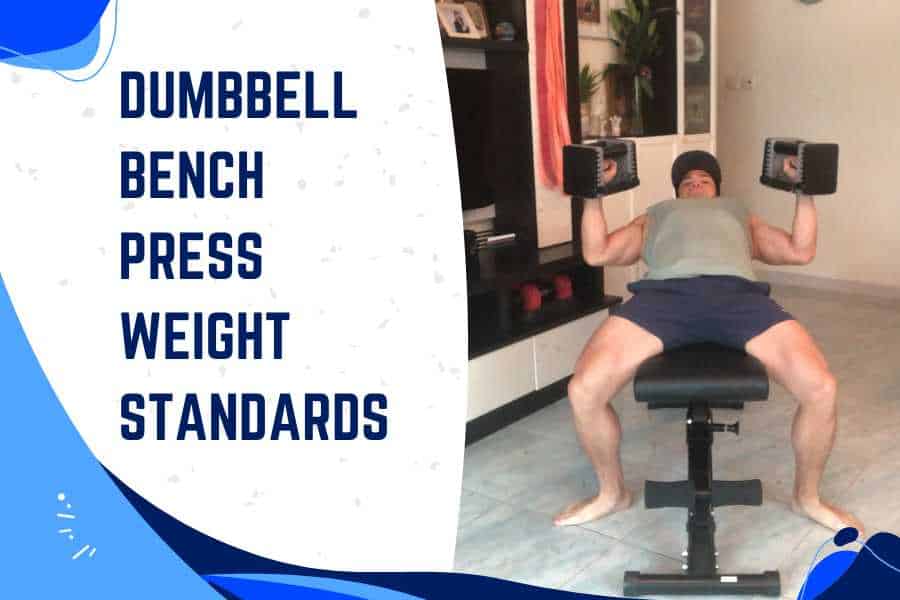The bench press is a popular dumbbell movement that people want to improve on. For best results, you should be lifting a suitable amount of weight. This post reveals dumbbell bench press weight standards to benchmark your performance.
A respectable dumbbell bench press for the average male beginner is around 45% of body weight for a single repetition and both dumbbells combined. Intermediates and advanced lifters should be able to lift around 90% and 130% (respectively) for 1 rep.
The weight standards in this post will help you determine what is a respectable weight to be lifting based on your gender, body weight, and training experience.
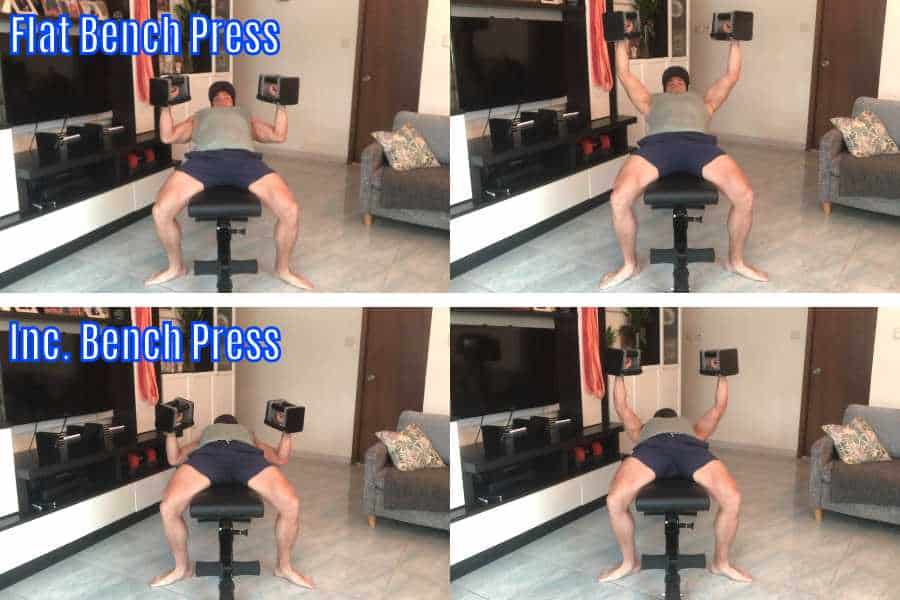
- How To Use These Weight Standards
- Beginner Flat Dumbbell Bench Press Weight Standards
- Intermediate Flat Dumbbell Bench Press Weight Standards
- Advanced Flat Dumbbell Bench Press Weight Standards
- How Good Is Your Flat Dumbbell Bench Press Vs Others?
- Beginner Incline Dumbbell Bench Press Weight Standards
- Intermediate Incline Dumbbell Bench Press Weight Standards
- Advanced Incline Dumbbell Bench Press Weight Standards
- How Good Is Your Incline Dumbbell Bench Press Vs Others?
- 5 Reasons Why Your Dumbbell Bench Pressing Strength Is Below Average
- Other Weight Standards For Dumbbell Bench Press Muscles
- Conclusion
How To Use These Weight Standards
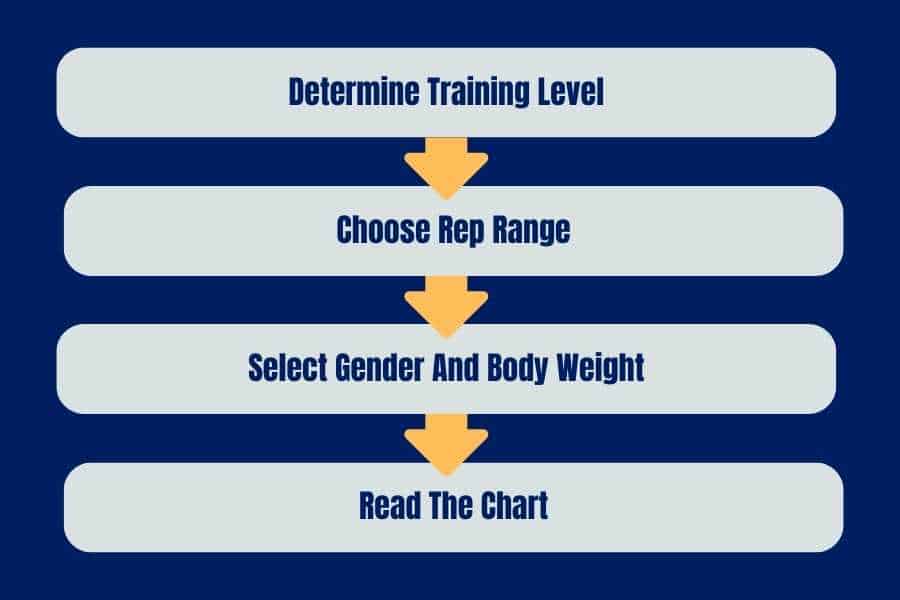
1) Determining your training level:
- Beginners have practiced the dumbbell bench press for 1-12 months.
- Intermediates have practiced the dumbbell bench press for 12-36 months.
- Advanced lifters have practiced the dumbbell bench press for 4 years or more.
2) Choosing your rep range:
The weight standards are given for:
- 1-rep max (1RM)- this is the maximum amount of weight you can lift for a single repetition. It’s often used as a strength standard.
- 6-10 working reps- this is generally considered to be the ideal rep range for building muscle.
3) Selecting your gender and body weight:
- Average dumbbell bench press weight standards are revealed for common body weights.
- Male bench press standards are given.
- Females can use a 60% conversion (multiply the weight standard by 0.60).
4) Reading the charts:
- Weight standards are given as lbs on the top and kg on the bottom.
- If you’re doing the bench press with dumbbells at or above the weight standard for your given training level, body weight, and gender, then you are lifting a respectable amount of weight.
Beginner Flat Dumbbell Bench Press Weight Standards
Here’s how much weight you should be flat dumbbell bench pressing as a beginner:
| Bodyweight | 1-rep max | 6-rep max | 7-rep max | 8-rep max | 9-rep max | 10-rep max |
|---|---|---|---|---|---|---|
| 120lb 54kg | 38lb 17kg | 32lb 15kg | 31lb 14kg | 30lb 14kg | 30lb 14kg | 28lb 13kg |
| 150lb 68kg | 58lb 26kg | 49lb 22kg | 48lb 22kg | 46lb 21kg | 45lb 20kg | 42lb 19kg |
| 200lb 91kg | 90lb 41kg | 76lb 34kg | 74lb 34kg | 72lb 33kg | 70lb 32kg | 66lb 30kg |
| 250lb 113kg | 120lb 54kg | 101lb 46kg | 98lb 44kg | 96lb 44kg | 94lb 43kg | 88lb 40kg |
| 300lb 136kg | 146lb 66kg | 123lb 62kg | 120lb 54kg | 117lb 53kg | 114lb 52kg | 107lb 49kg |
Generally speaking, beginners should be able to flat bench press with dumbbells that weigh 30 to 50% of their body weight (both dumbbells combined) for a single repetition (1-rep max).
Intermediate Flat Dumbbell Bench Press Weight Standards
Here’s how much weight you should be flat dumbbell bench pressing as an intermediate:
| Bodyweight | 1-rep max | 6-rep max | 7-rep max | 8-rep max | 9-rep max | 10-rep max |
|---|---|---|---|---|---|---|
| 120lb 54kg | 118lb 54kg | 99lb 45kg | 97lb 44kg | 94lb 43kg | 92lb 42kg | 86lb 39kg |
| 150lb 68kg | 152lb 69kg | 128lb 58kg | 125lb 57kg | 122lb 55kg | 120lb 54kg | 111lb 50kg |
| 200lb 91kg | 200lb 91kg | 168lb 76kg | 164lb 74kg | 160lb 73kg | 156lb 71kg | 146lb 66kg |
| 250lb 113kg | 242lb 110kg | 203lb 92kg | 198lb 135kg | 194lb 88kg | 189lb 86kg | 177lb 80kg |
| 300lb 136kg | 280lb 127kg | 235lb 107kg | 230lb 104kg | 224lb 102kg | 218lb 99kg | 204lb 93kg |
Generally speaking, intermediates should be able to flat bench press with dumbbells that weigh 90 to 100% of their body weight (both dumbbells combined) for a single repetition.
Advanced Flat Dumbbell Bench Press Weight Standards
Here’s how much weight you should be flat dumbbell bench pressing as an advanced lifter:
| Bodyweight | 1-rep max | 6-rep max | 7-rep max | 8-rep max | 9-rep max | 10-rep max |
|---|---|---|---|---|---|---|
| 120lb 54kg | 166lb 75kg | 139lb 63kg | 136lb 62kg | 133lb 60kg | 129lb 59kg | 121lb 55kg |
| 150lb 68kg | 216lb 98kg | 181lb 82kg | 177lb 80kg | 173lb 78kg | 168lb 76kg | 158lb 72kg |
| 200lb 91kg | 272lb 123kg | 228lb 103kg | 223lb 101kg | 218lb 99kg | 212lb 96kg | 199lb 90kg |
| 250lb 113kg | 322lb 146kg | 270lb 122kg | 264lb 120kg | 258lb 117kg | 251lb 114kg | 235lb 107kg |
| 300lb 136kg | 366lb 166kg | 307lb 139kg | 300lb 136kg | 293lb 133kg | 285lb 129kg | 267lb 121kg |
Generally speaking, advanced lifters should be able to flat bench press with dumbbells that weigh 120 to 140% (both dumbbells combined) of their body weight for a single repetition.
How Good Is Your Flat Dumbbell Bench Press Vs Others?
Here’s the average percentage of people who can do the flat bench press at a fraction of their own body weight using dumbbells:
| Flat Dumbbell Press 1RM Weight (as a fraction of body weight) | % Of People Who Can Do It |
|---|---|
| 0.10x | 100% |
| 0.20x | 100% |
| 0.30x | 99% |
| 0.40x | 97% |
| 0.50x | 93% |
| 0.60x | 87% |
| 0.70x | 79% |
| 0.80x | 70% |
| 0.90x | 60% |
| 1.00x | 50% |
| 1.10x | 40% |
| 1.20x | 32% |
| 1.30x | 24% |
| 1.40x | 18% |
| 1.50x | 13% |
| 1.60x | 9% |
| 1.70x | 6% |
| 1.80x | 4% |
| 1.90x | 3% |
| 2.00x | 2% |
This allows you to compare your standards with others and determine how good your strength is.
To calculate your flat dumbbell press as a fraction of your own body weight, simply divide the weight of your 1RM by your body weight.
For example: if you weigh 150lbs and your 1RM is 50lbs, then you’re lifting 0.33x your body weight (50lbs ÷ 150lbs).
The above chart indicates:
- 75% of people can flat dumbbell bench press 0.75x their body weight for 1 rep. This represents the lower quartile of lifters and is a respectable weight for beginners to achieve.
- 50% of people can flat dumbbell bench press 1.00x their body weight for 1 rep. This represents the median quartile of lifters and is a respectable weight for intermediates to achieve. It’s also a realistic target for beginners to aim towards with enough training.
- 25% of people can flat dumbbell bench press 1.30x their body weight for 1 rep. This represents the upper quartile of lifters and is a respectable weight for advanced lifters. It’s also a realistic target for intermediates to aim towards with enough training.
Beginner Incline Dumbbell Bench Press Weight Standards
Here’s how much weight you should be incline dumbbell bench pressing as a beginner:
| Bodyweight | 1-rep max | 6-rep max | 7-rep max | 8-rep max | 9-rep max | 10-rep max |
|---|---|---|---|---|---|---|
| 120lb 54kg | 48lb 22kg | 40lb 18kg | 39lb 18kg | 38lb 17kg | 37lb 17kg | 35lb 16kg |
| 150lb 68kg | 72lb 33kg | 60lb 27kg | 59lb 27kg | 58lb 26kg | 56lb 25kg | 53lb 24kg |
| 200lb 91kg | 108lb 49kg | 91lb 41kg | 89b 40kg | 86lb 39kg | 84lb 38kg | 79lb 36kg |
| 250lb 113kg | 142lb 64kg | 119lb 54kg | 116lb 53kg | 114lb 52kg | 111lb 50kg | 104lb 47kg |
| 300lb 136kg | 174lb 79kg | 146lb 66kg | 143lb 65kg | 139lb 63kg | 136lb 62kg | 127lb 58kg |
Generally speaking, beginners should be able to incline bench press with dumbbells that weigh 40 to 60% (both dumbbells combined) of their body weight for a single repetition.
Intermediate Incline Dumbbell Bench Press Weight Standards
Here’s how much weight you should be lifting on the incline dumbbell bench press as an intermediate lifter:
| Bodyweight | 1-rep max | 6-rep max | 7-rep max | 8-rep max | 9-rep max | 10-rep max |
|---|---|---|---|---|---|---|
| 120lb 54kg | 110lb 50kg | 92lb 42kg | 90lb 41kg | 88lb 33kg | 86lb 39kg | 80lb 36kg |
| 150lb 68kg | 144lb 65kg | 121lb 55kg | 118lb 54kg | 115lb 46kg | 112lb 51kg | 105lb 48kg |
| 200lb 91kg | 196lb 89kg | 165lb 75kg | 161lb 73kg | 157lb 64kg | 153lb 69kg | 143lb 65kg |
| 250lb 113kg | 240lb 109kg | 202lb 91kg | 197lb 89kg | 192lb 81kg | 187lb 85kg | 175lb 79kg |
| 300lb 136kg | 280lb 127kg | 235lb 107kg | 230lb 104kg | 224lb 96kg | 218lb 99kg | 204lb 93kg |
Generally speaking, intermediates should be able to do incline bench press with dumbbells that weigh 90% (both dumbbells combined) of their body weight for a single repetition.
Advanced Incline Dumbbell Bench Press Weight Standards
Here’s how much weight you should be lifting on the incline dumbbell bench press as an advanced lifter:
| Bodyweight | 1-rep max | 6-rep max | 7-rep max | 8-rep max | 9-rep max | 10-rep max |
|---|---|---|---|---|---|---|
| 120lb 54kg | 156lb 71kg | 131lb 59kg | 128lb 58kg | 125lb 57kg | 122lb 55kg | 114lb 52kg |
| 150lb 68kg | 196lb 89kg | 165lb 75kg | 161lb 73kg | 157lb 71kg | 153lb 69kg | 143lb 65kg |
| 200lb 91kg | 250lb 113kg | 220lb 95kg | 205lb 93kg | 200lb 91kg | 195lb 88kg | 183lb 83kg |
| 250lb 113kg | 300lb 136kg | 252lb 114kg | 246lb 112kg | 240lb 109kg | 234lb 106kg | 219lb 99kg |
| 300lb 136kg | 344lb 156kg | 289lb 131kg | 282lb 128kg | 275lb 125kg | 268lb 122kg | 251lb 114kg |
Generally speaking, an advanced lifter should be able to incline bench press with dumbbells that weigh 115 to 130% (both dumbbells combined) of their body weight for a single repetition.
How Good Is Your Incline Dumbbell Bench Press Vs Others?
Here’s the average percentage of people who can do the incline bench press at a fraction of their own body weight using dumbbells:
| Incline Dumbbell Press 1RM Weight (as a fraction of body weight) | % Of People Who Can Do It |
|---|---|
| 0.10x | 100% |
| 0.20x | 100% |
| 0.30x | 100% |
| 0.40x | 99% |
| 0.50x | 97% |
| 0.60x | 96% |
| 0.70x | 84% |
| 0.80x | 73% |
| 0.90x | 60% |
| 1.00x | 47% |
| 1.10x | 35% |
| 1.20x | 24% |
| 1.30x | 16% |
| 1.40x | 10% |
| 1.50x | 6% |
| 1.60x | 4% |
| 1.70x | 2% |
| 1.80x | 1% |
| 1.90x | 0.5% |
| 2.00x | 0.3% |
The above chart indicates:
- 75% of people can incline dumbbell bench press 0.80x their body weight for 1 rep. This represents the lower quartile of lifters and is a respectable weight for beginners to achieve.
- 50% of people can incline dumbbell bench press 1.00x their body weight for 1 rep. This represents the median quartile of lifters and is a respectable weight for intermediates to achieve. It’s also a realistic target for beginners to aim towards with enough training.
- 25% of people can incline dumbbell bench press 1.20x their body weight for 1 rep. This represents the upper quartile of lifters and is a respectable weight for advanced lifters. It’s also a realistic target for intermediates to aim towards with enough training.
5 Reasons Why Your Dumbbell Bench Pressing Strength Is Below Average
The pectorals and deltoids (primary target muscles in the bench press) are some of the most difficult muscles to build.
Here are 5 common reasons why you may find it difficult to do the bench press using dumbbells, and why your weight standards are below average.
I’ve also shared solutions for each problem.
These solutions can help to improve your dumbbell press.
1) Unstable lifting foundation
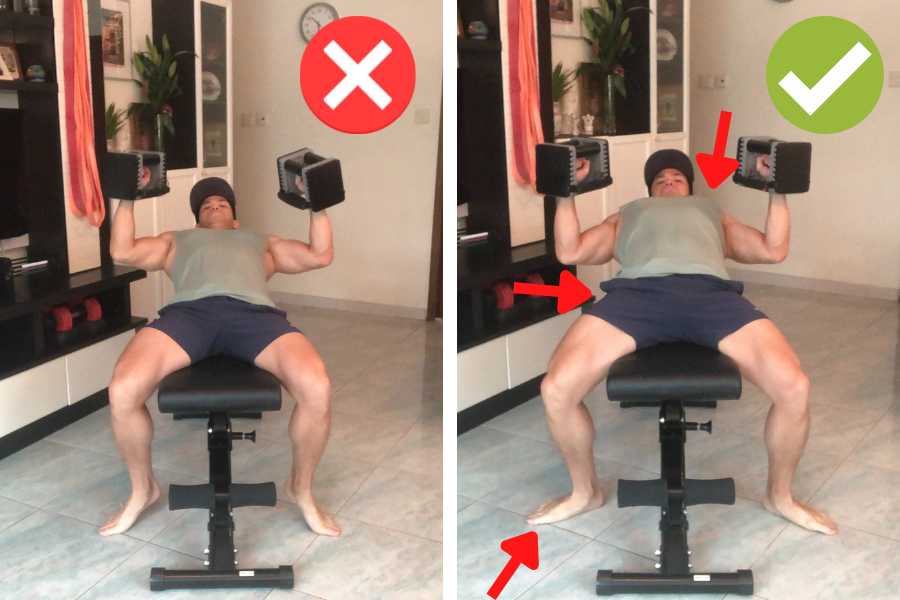
Unlike standing exercises, the dumbbell press requires you to lay on a flat or incline bench in order to push the weights upwards.
This inherently makes this movement unstable since you do not have your body weight pressing your feet into the ground.
Consequently, this can make the dumbbell bench press difficult and could be a reason why your strength standards are below average.
Solution:
Drive your feet into the ground for the entire duration of the dumbbell press. This provides the majority of the stability required to bench press heavy dumbbells.
Brace your core by taking in a deep breath and pushing your diaphragm outwards before each rep. This stabilizes your torso.
Arch your lower back to press your upper back into the bench. This completes a three-point contact (feet-floor, buttocks-bench, back-bench) for maximal stability.
These three form cues will help you to lift more weight, develop a stronger bench press, and build bigger pectorals using your dumbbells.
2) Flared elbows
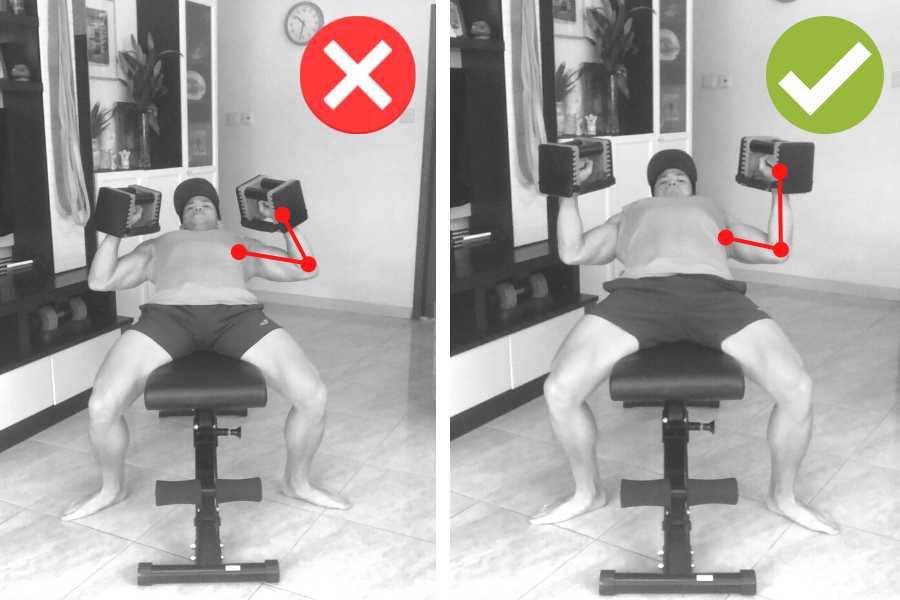
The position of your dumbbells and wrist relative to your elbows is important.
In fact, beginners often find the dumbbell bench press hard because of this simple but often-missed form cue.
Your elbows should not be flared outwards.
Why?
Firstly, flaring your elbows introduces internal rotation into the movement. This can be uncomfortable and even painful.
Secondly, it’s a matter of physics. If dumbbells aren’t stacked directly above your elbows, you won’t be able to transmit the force from your pecs to the dumbbells.
Both reasons could lead to a weaker dumbbell bench press.
Solution:
Tuck your elbows slightly in towards the torso to allow you to stack the dumbbells directly above your elbows.
This helps you to push the dumbbells with your chest rather than with your arms.
The elbow tuck is an essential form cue that can help to explode your bench press, whether you’re lifting dumbbells or a barbell.
You may also be interested in my barbell vs dumbbell bench press weight comparison.
3) Working in high-rep ranges
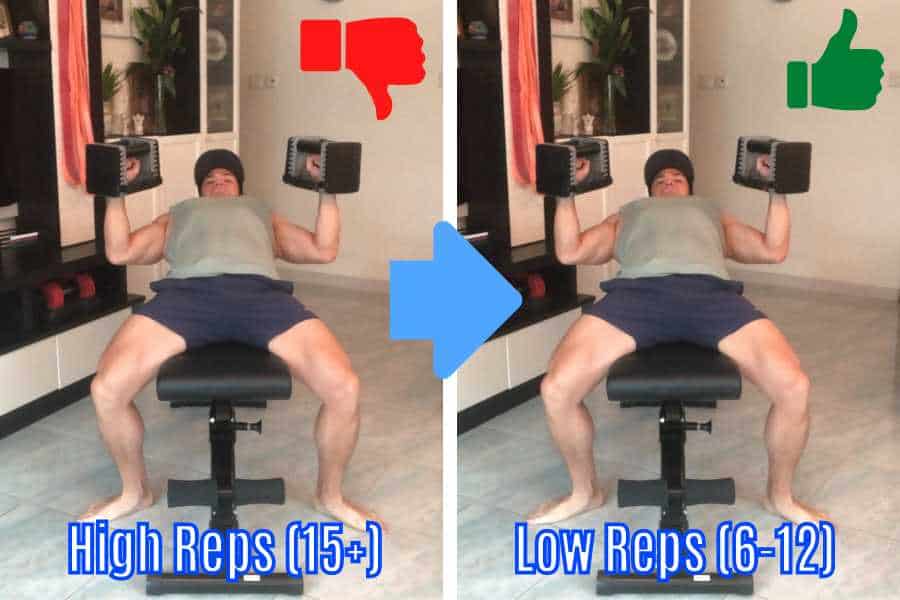
Bench pressing with dumbbells is compound by nature, and these types of exercises work best in lower rep ranges.
Let’s clarify- it’s ok if you are a skinny beginner to lift light and in high rep ranges of 15+ per set when you first start training.
But you should ideally move onto lower rep ranges of 6-12 using heavier weights as soon as possible.
Heavy lifting is ideal for building muscle, gaining strength, and improving your dumbbell bench press.
Solution:
As an untrained beginner, spend 2 weeks lifting light dumbbells for 15 reps per set. Complete 3 to 4 sets per workout.
After those 2 weeks, you can start to apply progressive overload by lifting heavier dumbbells and reducing reps.
Note- lifting heavy is recommended for muscle growth (hypertrophy), but the weight should also be light enough for you to lift it with a slow and controlled form.
For more details, you can check out my other post on choosing the ideal weight to lift.
4) Weak primary drivers and stabilizers

The primary target muscles for the dumbbell bench press include:
- Pectorals.
- Anterior deltoids.
- Triceps.
Muscles that serve as stabilizers include:
- Lateral and posterior deltoids.
- Trapezius.
- Lats.
- Core.
- Biceps.
Weakness in any of these muscles can make the dumbbell bench press harder to perform and result in below-average strength standards.
Solution:
Be patient, keep practicing the bench press, and regularly overload in small weight increments.
Train with a full range of motion by bringing the dumbells all the way down to the chest before pressing them up.
Half and cheat reps might make you feel good because they allow heavier dumbbells to be lifted, but they are generally unsuitable for overall strength gains and building a legitimately strong bench press.
Include accessory dumbbell chest movements into your program. Many of these do not even need a bench, but they can still help to strengthen your pecs and improve your bench press.
Additionally, you can also try other bench press variations to emphasize different muscles in the chest, arms, and shoulders.
5) Insufficient nutrition

Poor nutrition is one of the most common reasons why pecs won’t grow.
You could be following the best chest workout program in the world; but if you aren’t going on an effective bulk, you will not build a significant amount of muscle.
The converse is true- following a good bulking diet is key for building a bigger and stronger bench press with dumbbells.
Solution:
Determine your maintenance calories using the TDEE calculator and add 5-15% to establish your daily bulking calories. This is how much you should be eating every day to build muscle and strength.
Additionally, aim to eat at least 1 gram of protein per lb of body weight.
For a detailed guide, you can check out my home bulking routine for skinny guys.
Other Weight Standards For Dumbbell Bench Press Muscles
The dumbbell bench press is a horizontal compound pushing movement that primarily works the pecs and delts, but also the triceps. Here are weight standards for other exercises that hit similar muscle groups:
- Dips– a compound pushing exercise that’s an effective bodyweight alternative to the bench press.
- Dumbbell flyes– an isolation-type movement that emphasizes the pectorals.
- Shoulder press with dumbbells– vertical compound pushing exercise that focuses on the deltoids but also works the upper pecs.
- Dumbbell extension– an isolation-type movement that emphasizes the triceps.
You may also be interested in my other post for the world’s strongest bench press records!
Conclusion
These flat and incline dumbbell bench press weight standards help you to determine whether or not you are lifting a respectable amount of weight for your capabilities.
Beginners should be able to do 1 rep using around 45% of their body weight (both dumbbells combined). Intermediates should be able to lift approximately 90% of their body weight, and advanced lifters approximately 130%.
If you’re lifting at or exceeding these strength standards, then you’re doing a good and respectable job.
I’ve also shared common problems and solutions to a bench press strength that is below average.
You may also be interested in the downloadable Kalibre Blueprint PDF which details exactly how I gained 40lbs of lean muscle (it’s 100% free!). It details the exact exercises and nutrition (with printables) I used to go from skinny to ripped!

